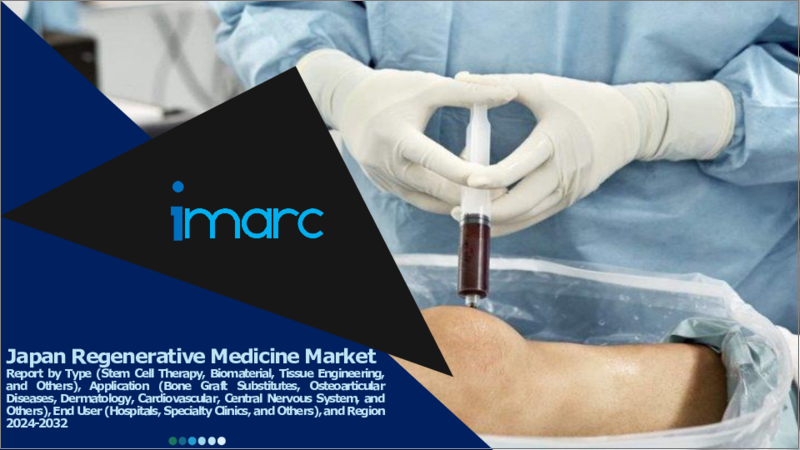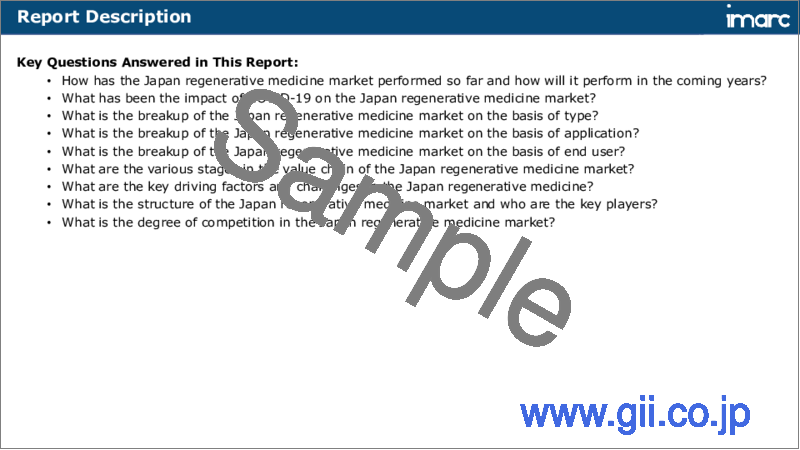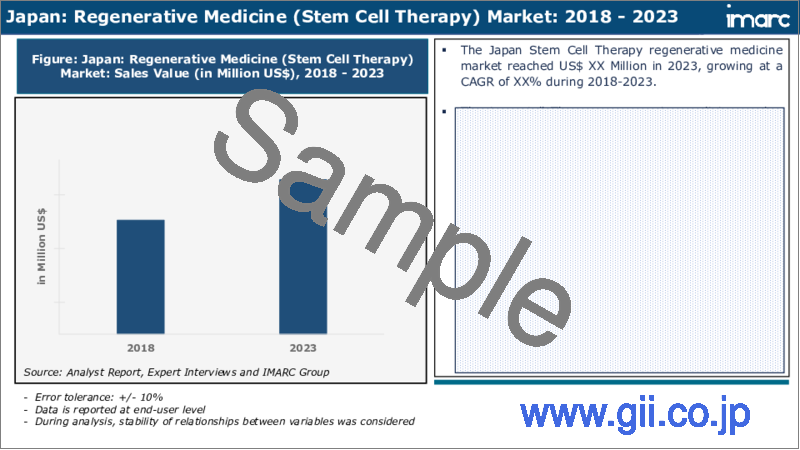|
|
市場調査レポート
商品コード
1609789
日本の再生医療市場レポート:タイプ、用途、エンドユーザー、地域別、2024年~2032年Japan Regenerative Medicine Market Report by Type, Application, End User, and Region 2024-2032 |
||||||
カスタマイズ可能
|
|||||||
| 日本の再生医療市場レポート:タイプ、用途、エンドユーザー、地域別、2024年~2032年 |
|
出版日: 2024年12月05日
発行: IMARC
ページ情報: 英文 121 Pages
納期: 5~7営業日
|
- 全表示
- 概要
- 目次
日本の再生医療市場の市場規模は2023年に76億米ドルに達しました。今後、IMARC Groupは、同市場が2032年までに231億米ドルに達し、2024年から2032年の間に11.70%の成長率(CAGR)を示すと予測しています。この市場を牽引しているのは、移植拒絶反応に対する懸念の高まり、再生整形外科治療へのニーズの高まり、歯科再生への注目の高まり、創傷治癒のための医療利用の拡大など、さまざまな要因です。
本レポートで扱う主な質問
- 日本の再生医療市場のこれまでの業績と、今後数年間の業績は?
- COVID-19の日本の再生医療市場への影響は?
- 日本の再生医療市場のタイプ別の内訳は?
- 日本の再生医療市場の用途別の内訳は?
- 日本の再生医療市場のエンドユーザー別の内訳は?
- 日本の再生医療市場のバリューチェーンにはどのような段階がありますか?
- 日本の再生医療における主な促進要因と課題は何か?
- 日本の再生医療市場の構造と主要プレーヤーは?
- 日本の再生医療市場における競合の程度は?
目次
第1章 序文
第2章 調査範囲と調査手法
- 調査の目的
- ステークホルダー
- データソース
- 市場推定
- 調査手法
第3章 エグゼクティブサマリー
第4章 日本の再生医療市場:イントロダクション
- 概要
- 市場力学
- 業界動向
- 競合情報
第5章 日本の再生医療市場情勢
- 過去および現在の市場動向(2018~2023年)
- 市場予測(2024~2032年)
第6章 日本の再生医療市場:タイプ別の内訳
- 幹細胞療法
- 生体材料
- 組織工学
- その他
第7章 日本の再生医療市場:用途別の内訳
- 骨移植代替品
- 骨関節疾患
- 皮膚科
- 心臓血管
- 中枢神経系
- その他
第8章 日本の再生医療市場:エンドユーザー別の内訳
- 病院
- 専門クリニック
- その他
第9章 日本の再生医療市場:競合情勢
- 概要
- 市場構造
- 市場プレーヤーのポジショニング
- 主要成功戦略
- 競合ダッシュボード
- 企業評価象限
第10章 主要企業のプロファイル
第11章 日本の再生医療市場:業界分析
- 促進要因・抑制要因・機会
- ポーターのファイブフォース分析
- バリューチェーン分析
第12章 付録
Japan regenerative medicine market size reached US$ 7.6 Billion in 2023. Looking forward, IMARC Group expects the market to reach US$ 23.1 Billion by 2032, exhibiting a growth rate (CAGR) of 11.70% during 2024-2032. The market is being driven by a range of factors, including heightened worries about transplant rejection, a greater need for regenerative orthopedic treatments, an increasing focus on dental regeneration, and the growing utilization of medicine for wound healing.
Regenerative medicine is an auspicious field within biomedical science that focuses on repairing damaged tissues and organs. It involves the use of laboratory-cultivated stem cells, which are safely transplanted into the body to encourage the regeneration of various bodily components such as bones, cartilage, blood vessels, and essential organs. This comprehensive approach includes a variety of regenerative therapies, both cellular and acellular, incorporating techniques like immunomodulation and tissue engineering. Apart from its role in tissue repair, regenerative medicine shows great promise in addressing persistent conditions such as Alzheimer's, Parkinson's, cardiovascular diseases (CVDs), osteoporosis, and spinal cord injuries. As research progresses, it presents an optimistic outlook for revolutionary treatments that have the potential to significantly enhance patients' quality of life and overall healthcare outcomes.
Japan Regenerative Medicine Market Trends:
The Japan regenerative medicine market is experiencing substantial growth primarily due to the expanding elderly population. This demographic shift correlates with a heightened incidence of chronic ailments like diabetes, heart disease, and osteoarthritis, thus significantly contributing to the market's expansion. Moreover, the increasing focus on stem cell therapies and genetic engineering research is fostering innovation within the realm of regenerative medicine. The market is further stimulated by the growing utilization of stem cells and other cell-based therapies for the purpose of tissue regeneration and repair. Notably, the positive trajectory of the market is sustained by the allocation of funding and regulatory support for the advancement of regenerative medicine research and development. The continual advancements in biotechnology are facilitating the development of more precise and efficacious regenerative therapies, thereby bolstering the market's growth. Additionally, the rising awareness among patients regarding the availability of regenerative treatment options is serving as an additional catalyst for market expansion. The increasing occurrence of cancer and the quest for treatments that are both more efficient and accommodating for patients are driving the need for regenerative medicine in cancer treatment, playing a substantial role in the growth of the market.
Japan Regenerative Medicine Market Segmentation:
Type Insights:
- Stem Cell Therapy
- Biomaterial
- Tissue Engineering
- Others
Application Insights:
- Bone Graft Substitutes
- Osteoarticular Diseases
- Dermatology
- Cardiovascular
- Central Nervous System
- Others
End User Insights:
- Hospitals
- Specialty Clinics
- Others
Competitive Landscape:
The market research report has also provided a comprehensive analysis of the competitive landscape. Competitive analysis such as market structure, key player positioning, top winning strategies, competitive dashboard, and company evaluation quadrant has been covered in the report. Also, detailed profiles of all major companies have been provided.
Key Questions Answered in This Report:
- How has the Japan regenerative medicine market performed so far and how will it perform in the coming years?
- What has been the impact of COVID-19 on the Japan regenerative medicine market?
- What is the breakup of the Japan regenerative medicine market on the basis of type?
- What is the breakup of the Japan regenerative medicine market on the basis of application?
- What is the breakup of the Japan regenerative medicine market on the basis of end user?
- What are the various stages in the value chain of the Japan regenerative medicine market?
- What are the key driving factors and challenges in the Japan regenerative medicine?
- What is the structure of the Japan regenerative medicine market and who are the key players?
- What is the degree of competition in the Japan regenerative medicine market?
Table of Contents
1 Preface
2 Scope and Methodology
- 2.1 Objectives of the Study
- 2.2 Stakeholders
- 2.3 Data Sources
- 2.3.1 Primary Sources
- 2.3.2 Secondary Sources
- 2.4 Market Estimation
- 2.4.1 Bottom-Up Approach
- 2.4.2 Top-Down Approach
- 2.5 Forecasting Methodology
3 Executive Summary
4 Japan Regenerative Medicine Market - Introduction
- 4.1 Overview
- 4.2 Market Dynamics
- 4.3 Industry Trends
- 4.4 Competitive Intelligence
5 Japan Regenerative Medicine Market Landscape
- 5.1 Historical and Current Market Trends (2018-2023)
- 5.2 Market Forecast (2024-2032)
6 Japan Regenerative Medicine Market - Breakup by Type
- 6.1 Stem Cell Therapy
- 6.1.1 Overview
- 6.1.2 Historical and Current Market Trends (2018-2023)
- 6.1.3 Market Forecast (2024-2032)
- 6.2 Biomaterial
- 6.2.1 Overview
- 6.2.2 Historical and Current Market Trends (2018-2023)
- 6.2.3 Market Forecast (2024-2032)
- 6.3 Tissue Engineering
- 6.3.1 Overview
- 6.3.2 Historical and Current Market Trends (2018-2023)
- 6.3.3 Market Forecast (2024-2032)
- 6.4 Others
- 6.4.1 Historical and Current Market Trends (2018-2023)
- 6.4.2 Market Forecast (2024-2032)
7 Japan Regenerative Medicine Market - Breakup by Application
- 7.1 Bone Graft Substitutes
- 7.1.1 Overview
- 7.1.2 Historical and Current Market Trends (2018-2023)
- 7.1.3 Market Forecast (2024-2032)
- 7.2 Osteoarticular Diseases
- 7.2.1 Overview
- 7.2.2 Historical and Current Market Trends (2018-2023)
- 7.2.3 Market Forecast (2024-2032)
- 7.3 Dermatology
- 7.3.1 Overview
- 7.3.2 Historical and Current Market Trends (2018-2023)
- 7.3.3 Market Forecast (2024-2032)
- 7.4 Cardiovascular
- 7.4.1 Overview
- 7.4.2 Historical and Current Market Trends (2018-2023)
- 7.4.3 Market Forecast (2024-2032)
- 7.5 Central Nervous System
- 7.5.1 Overview
- 7.5.2 Historical and Current Market Trends (2018-2023)
- 7.5.3 Market Forecast (2024-2032)
- 7.6 Others
- 7.6.1 Historical and Current Market Trends (2018-2023)
- 7.6.2 Market Forecast (2024-2032)
8 Japan Regenerative Medicine Market - Breakup by End User
- 8.1 Hospitals
- 8.1.1 Overview
- 8.1.2 Historical and Current Market Trends (2018-2023)
- 8.1.3 Market Forecast (2024-2032)
- 8.2 Specialty Clinics
- 8.2.1 Overview
- 8.2.2 Historical and Current Market Trends (2018-2023)
- 8.2.3 Market Forecast (2024-2032)
- 8.3 Others
- 8.3.1 Historical and Current Market Trends (2018-2023)
- 8.3.2 Market Forecast (2024-2032)
9 Japan Regenerative Medicine Market - Competitive Landscape
- 9.1 Overview
- 9.2 Market Structure
- 9.3 Market Player Positioning
- 9.4 Top Winning Strategies
- 9.5 Competitive Dashboard
- 9.6 Company Evaluation Quadrant
10 Profiles of Key Players
- 10.1 Company A
- 10.1.1 Business Overview
- 10.1.2 Product Portfolio
- 10.1.3 Business Strategies
- 10.1.4 SWOT Analysis
- 10.1.5 Major News and Events
- 10.2 Company B
- 10.2.1 Business Overview
- 10.2.2 Product Portfolio
- 10.2.3 Business Strategies
- 10.2.4 SWOT Analysis
- 10.2.5 Major News and Events
- 10.3 Company C
- 10.3.1 Business Overview
- 10.3.2 Product Portfolio
- 10.3.3 Business Strategies
- 10.3.4 SWOT Analysis
- 10.3.5 Major News and Events
- 10.4 Company D
- 10.4.1 Business Overview
- 10.4.2 Product Portfolio
- 10.4.3 Business Strategies
- 10.4.4 SWOT Analysis
- 10.4.5 Major News and Events
- 10.5 Company E
- 10.5.1 Business Overview
- 10.5.2 Product Portfolio
- 10.5.3 Business Strategies
- 10.5.4 SWOT Analysis
- 10.5.5 Major News and Events
11 Japan Regenerative Medicine Market - Industry Analysis
- 11.1 Drivers, Restraints, and Opportunities
- 11.1.1 Overview
- 11.1.2 Drivers
- 11.1.3 Restraints
- 11.1.4 Opportunities
- 11.2 Porters Five Forces Analysis
- 11.2.1 Overview
- 11.2.2 Bargaining Power of Buyers
- 11.2.3 Bargaining Power of Suppliers
- 11.2.4 Degree of Competition
- 11.2.5 Threat of New Entrants
- 11.2.6 Threat of Substitutes
- 11.3 Value Chain Analysis





